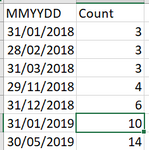FabCon is coming to Atlanta
Join us at FabCon Atlanta from March 16 - 20, 2026, for the ultimate Fabric, Power BI, AI and SQL community-led event. Save $200 with code FABCOMM.
Register now!- Power BI forums
- Get Help with Power BI
- Desktop
- Service
- Report Server
- Power Query
- Mobile Apps
- Developer
- DAX Commands and Tips
- Custom Visuals Development Discussion
- Health and Life Sciences
- Power BI Spanish forums
- Translated Spanish Desktop
- Training and Consulting
- Instructor Led Training
- Dashboard in a Day for Women, by Women
- Galleries
- Data Stories Gallery
- Themes Gallery
- Contests Gallery
- QuickViz Gallery
- Quick Measures Gallery
- Visual Calculations Gallery
- Notebook Gallery
- Translytical Task Flow Gallery
- TMDL Gallery
- R Script Showcase
- Webinars and Video Gallery
- Ideas
- Custom Visuals Ideas (read-only)
- Issues
- Issues
- Events
- Upcoming Events
The Power BI Data Visualization World Championships is back! Get ahead of the game and start preparing now! Learn more
- Power BI forums
- Forums
- Get Help with Power BI
- DAX Commands and Tips
- Re: Dax conditional If statement for counting rows...
- Subscribe to RSS Feed
- Mark Topic as New
- Mark Topic as Read
- Float this Topic for Current User
- Bookmark
- Subscribe
- Printer Friendly Page
- Mark as New
- Bookmark
- Subscribe
- Mute
- Subscribe to RSS Feed
- Permalink
- Report Inappropriate Content
Dax conditional If statement for counting rows in date table
Hello all,
I am trying to use CountRows, but toiling a bit with a conditional if statement. I have the following date table called MMYYDD
| MMYYDD | Count |
| 31/01/2018 | 3 |
| 28/02/2018 | 3 |
| 31/03/2018 | 3 |
| 29/11/2018 | 4 |
| 31/12/2018 | 6 |
| 31/01/2019 | 10 |
| 30/05/2019 | 14 |
And another table called 'Summary'
| MinDate | MaxDate | RejoinDate | DateEnd |
| 01-Jan-18 | 30-Apr-22 | 30/04/2021 | 29/04/2020 |
| 01-Jan-18 | 30-Nov-23 | 23/11/2021 | 30/03/2020 |
| 01-Jan-18 | 31-May-23 | 31/05/2021 | |
| 31-Jan-19 | 28-Feb-22 | 19/01/2021 | 31/01/2020 |
| 31-Jan-19 | 31-Jan-24 | 20/01/2023 | 31/01/2022 |
| 30-May-19 | 31-May-22 | 31/05/2020 | |
| 31-Jan-19 | 29-Feb-24 | 11/12/2020 | |
| 31-Dec-18 | 31-Mar-24 | 19/03/2021 | 31/12/2020 |
| 31-Dec-18 | 31-Oct-23 | 26/08/2020 | 31/12/2019 |
| 17-Apr-19 | 30-Apr-24 | 01/02/2023 | |
| 31-Jan-19 | 31-Dec-22 | 15/10/2020 | 30/09/2020 |
| 29-Nov-18 | 31-Jan-24 | 30/11/2019 | |
| 29-May-19 | 30-Sep-23 | 26/09/2022 | 31/05/2022 |
| 16-Dec-19 | 30-Apr-24 | 31/01/2021 | 18/12/2019 |
The 'Count' column in the MMYYDD table is calculated as below:-
Count =
COUNTROWS (
FILTER (
'Summary',
[MMYYDD] >= 'Summary'[MinDate]
&& [MMYYDD] < 'Summary'[MaxDate]
)
)
I would like to add a second Count to the MMYYDD table that counts both of the following conditions:-
Condition 1. [MMYYDD] >= 'Summary'[MinDate] && [MMYYDD] < 'Summary'[DateEnd]
Condition 2. [MMYYDD] >= 'Summary'[RejoinDate] && [MMYYDD] < 'Summary'[MaxDate]
However only count Condition 1 if 'Summary'[DateEnd] is not blank
and only count Condition 2 if 'Summary'[RejoinDate] is not blank
If condition 1 or condition 2 is blank then
[MMYYDD] >= 'Summary'[MinDate] && [MMYYDD] < 'Summary'[MaxDate]
Any ideas and massive thanks for anyone that can help!
Solved! Go to Solution.
- Mark as New
- Bookmark
- Subscribe
- Mute
- Subscribe to RSS Feed
- Permalink
- Report Inappropriate Content
here's a general idea of how to implement that
ct2 =
VAR a =
SUMMARIZE(
MMYYDD,
MMYYDD[MMYYDD],
"ct",
VAR d = [MMYYDD]
RETURN
CALCULATE(
COUNTROWS( Summary ),
COALESCE( Summary[RejoinDate], Summary[MinDate] ) <= d,
COALESCE( Summary[DateEnd], Summary[MaxDate] ) > d
)
)
RETURN
SUMX( a, [ct] )
You can refine the logic by testing for both conditions together.
- Mark as New
- Bookmark
- Subscribe
- Mute
- Subscribe to RSS Feed
- Permalink
- Report Inappropriate Content
- Mark as New
- Bookmark
- Subscribe
- Mute
- Subscribe to RSS Feed
- Permalink
- Report Inappropriate Content
here's a general idea of how to implement that
ct2 =
VAR a =
SUMMARIZE(
MMYYDD,
MMYYDD[MMYYDD],
"ct",
VAR d = [MMYYDD]
RETURN
CALCULATE(
COUNTROWS( Summary ),
COALESCE( Summary[RejoinDate], Summary[MinDate] ) <= d,
COALESCE( Summary[DateEnd], Summary[MaxDate] ) > d
)
)
RETURN
SUMX( a, [ct] )
You can refine the logic by testing for both conditions together.
Helpful resources

Power BI Dataviz World Championships
The Power BI Data Visualization World Championships is back! Get ahead of the game and start preparing now!

| User | Count |
|---|---|
| 19 | |
| 13 | |
| 9 | |
| 4 | |
| 4 |
| User | Count |
|---|---|
| 30 | |
| 26 | |
| 17 | |
| 11 | |
| 10 |




